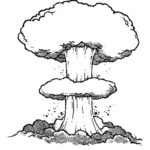“Enemy-making seems to serve a vital purpose: those qualities that we cannot tolerate in ourselves we can unconsciously and painlessly attribute to our enemies. When observed through psychological lenses, enemy-making is a transposition of shadow onto others who, for often complicated reasons, fit our images of the inferior. We need only to think of the people whom we judge or dislike or against whom we hold secret prejudices to find ourselves in the grip of our shadow nature.
At the level of nation, race, religion, or other collective identity, we can witness enemy-making being enacted in mythic, dramatic, and often tragic proportions. Wars, crusades, and persecutions are the terrible estate of this form of the human shadow, which is, to some degree, a legacy of our instinctual tribal heritage. The greatest cruelties in human history have been carried out in the name of righteous causes, when the shadows of entire nations have been projected onto the face of an enemy and thus an alien group can be made into a foe, a scapegoat, or an infidel.”
–Introduction to Part 8, “Enemy-making: Us and Them in the Body Politic,” from Meeting the Shadow, edited by Connie Zweig and Jeremiah Abrams, pg 195.

“Generation after generation, we find excuses to hate and dehumanize each other, and we always justify ourselves with the most mature-sounding political rhetoric. And we refuse to admit the obvious. We human beings are homo hostilis, the hostile species, the enemy-making animal. We are driven to fabricate an enemy as a scapegoat to bear the burden of our denied enmity. From the unconscious residue of our hostility, we create a target; from our private demons, we conjure a public enemy. And perhaps, more than anything else, the wars we engage in are compulsive rituals, shadow dramas in which we continually try to kill those parts of ourselves we deny and despise.”
–Essay from Meeting the Shadow by Sam Keen, “The Enemy Maker,” pg 198.
